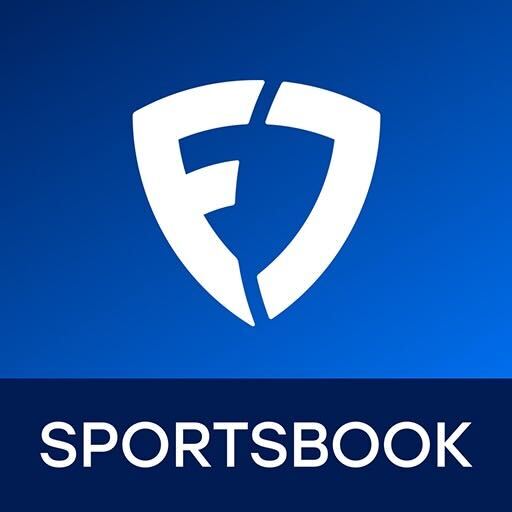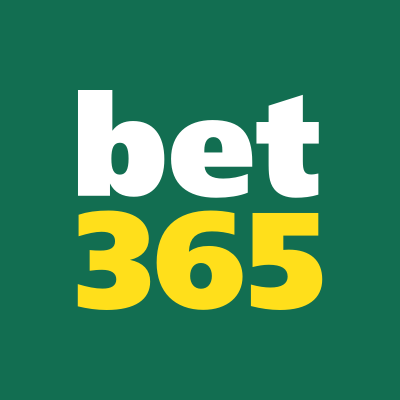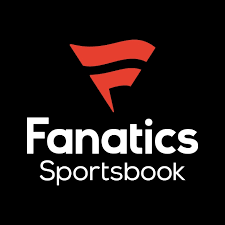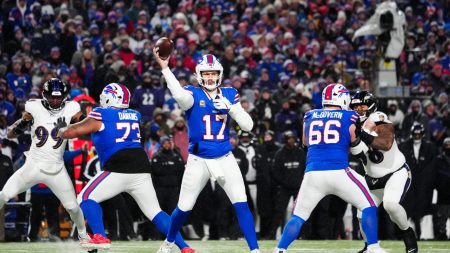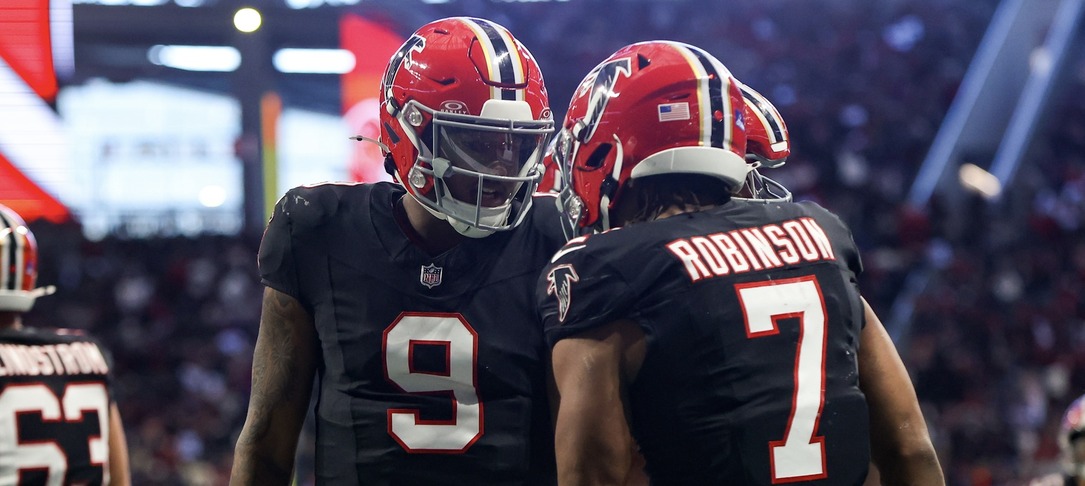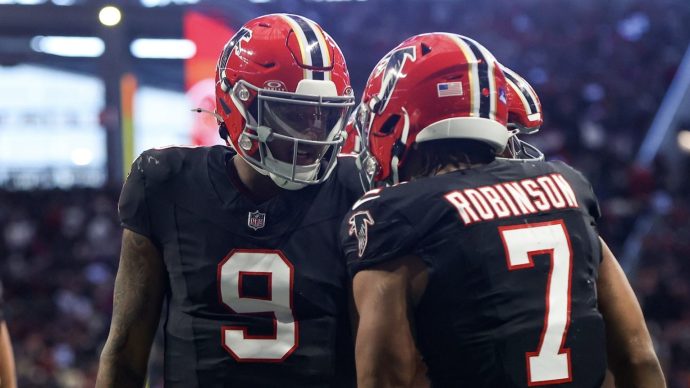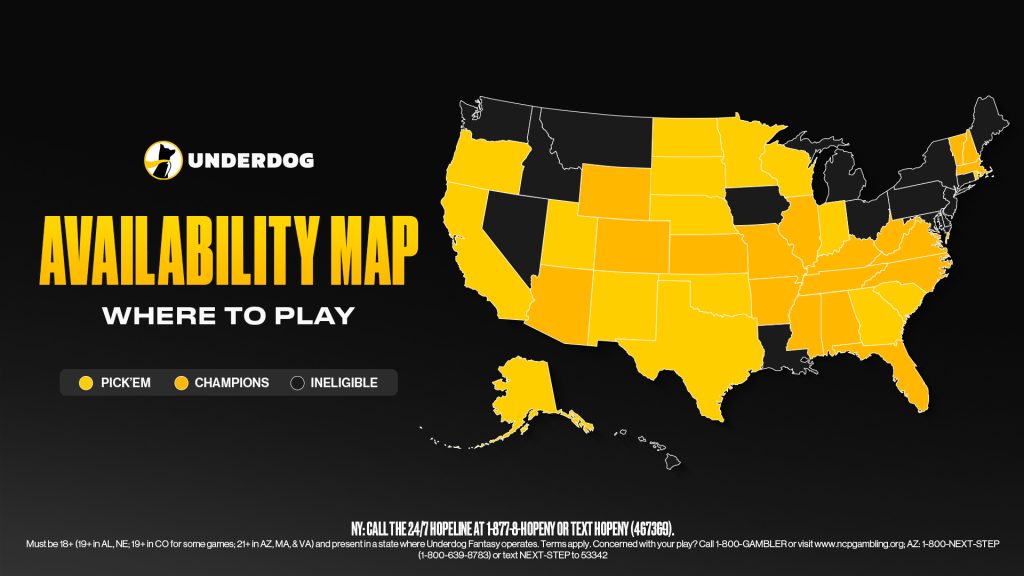In this article, our expert analysts outline their favorite NFL player props for every week of the season. For each major slate, including top showdown games, we’ll break it all down from a DFS and betting perspective.
Editor’s Note: Did you know DFS pick’em apps like Underdog and Sleeper are live in many states where online sports betting isn’t yet legal? Use promo code PROPS when signing up to get started!
Best DFS Apps in All States


We also provide FREE NFL player prop odds across multiple markets for all of the major sportsbooks and DFS pick’em sites.
Check it out below!
Live Odds
Below, you’ll see our top NFL player prop picks across different categories like yardage, touchdowns, interceptions, completions, attempts, and more.
In other words, if there’s an NFL player prop with value, then you better believe we are going for it.
Best NFL player props today
Our analysts run through their favorite NFL player props for the major slates each week.
Here are our best NFL Week 18.
Brock Purdy > 243.5 Passing Yards
Brock Purdy’s man vs. zone splits are pretty interesting, and this is important because, according to Fantasy Points data, Seattle plays the 5th-most zone coverage in the league. That’s critical context for how this game sets up.
Now, against zone coverage, Purdy is throwing 5 touchdowns and 9 interceptions this year. That’s not good, I’m not going to sugarcoat it. Compare that to man coverage, where he’s throwing 8 touchdowns and 0 interceptions – massive difference in efficiency there.
However, here’s where it gets interesting. Against zone coverage, Purdy is almost 2 full yards per attempt higher with a higher adjusted completion percentage compared to man coverage. Those are all legitimately good things for a passing yards prop.
I really don’t care if he ends up turning the ball over tonight – we’re going to chalk those interceptions up to variance here. The volume and yardage production are what matter for this bet.
I think Purdy is going to have to throw the ball against Seattle, and hopefully, there’s some short, easy stuff with yards-after-catch opportunity against a soft Seattle zone defense. Their run defense is pretty good, which should force the 49ers to throw more than they might prefer.
Hopefully Kyle Shanahan gets Christian McCaffrey in space on some screen passes and swing routes, and Purdy won’t have to work too hard to rack up some yards through the air.
Play on: Underdog
Derrick Henry > 89.5 Rushing Yards
They’re going to feed this guy to try to make the postseason. We see it every year when the Ravens need to win and control the clock – they hand the ball to their workhorse back and let him eat.
Father Time has caught up to Henry a little bit, especially this season. And with an ailing Lamar Jackson potentially limited, Baltimore is going to try to run the ball right into the heart of this Pittsburgh defense to take pressure off their franchise quarterback.
The Steelers have shown some legitimate vulnerabilities and issues stopping the run at times this season, failing to adjust at certain points when teams commit to pounding the rock. They’re not the Steel Curtain defense of years past.
I believe that Derrick Henry, in this cold weather in a very important divisional game, is going to get a ton of volume at a minimum. Even if he’s not ultra-efficient, the carries should be there to clear 89.5 yards.
Play on: Underdog
Looking for more NFL betting and DFS content?
Check our links below! As always, everything is 100% free to read:
- NFL News Hub
- Week 15 Cheat Sheet
- Anytime Touchdown Scorers
- First Touchdown Scorers
- Passing Props
- Rushing Props
- Receiving Props
- Monday Night Football Props
- Thursday Night Football Props
- Sunday Night Football Props
Where to place NFL player prop bets
The best sportsbooks for NFL player prop betting are FanDuel, DraftKings, BetMGM, Caesars, bet365, and Fanatics. You’ll find large prop menus, solid Same-Game Parlay (SGP) tools, live betting, regular promos, and simple, easy to use apps. The mix varies by book.
FanDuel and DraftKings stand out for the number of props and easy SGP builders. BetMGM is reliable for competitive odds and a strong rewards program. Caesars posts deep markets, including novelty options, and bet365 is strong in live betting.
Newer books like Fanatics are building comprehensive prop offerings too, so you have plenty of places to compare odds.

What are the available stat-based NFL player props?
Stat-based NFL player props focus on individual stat lines for a single game, no matter the position. Most are set as over or under on a posted number. Unlike positional markets, you judge projected volume, efficiency, and matchup strength to decide whether a player goes over the line or under it.
Here are the main categories on offer, and how to approach each one without overcomplicating it.
Touchdowns (anytime, first, OR last)
Touchdown scorer markets come in a few different versions with different levels of risk and reward. They are popular because the bet is easy to understand, and the payouts can be high.
Anytime touchdown props ask a simple question, will a player score at least one touchdown at any point in the game. First touchdown props pay if your pick scores the game’s first TD, while last touchdown props grade the final scorer. The odds stretch as the prediction gets harder. Picking the exact first or last scorer is tougher than anytime, so the price is bigger.
These bets are about opportunity, and usage near the goal line is the clearest sign. Players who consistently touch the ball inside the 10-yard line (targets or carries) are more likely to score a touchdown. Watch how a team calls plays near the goal line to see who gets the ball.
Team scoring outlook matters too. A player on a high-powered offense projected around 28 or more points will see more chances than someone on a team expected to score fewer than 20. More points usually means more touchdown chances.
Player role is the next filter. A running back who handles most goal line carries is a safer anytime TD bet than a receiver sharing red zone targets with two teammates. You are buying touches as much as talent.
Touchdown props have more variance than yardage or receptions, but the payouts often compensate. If you stick to dependable near goal line roles, the anytime market can be a good hunting ground for value. First and last TD bets are more volatile because the odds are higher, which reflects the added unpredictability. Consider smaller stakes for those.
Total yards (passing, rushing, receiving)
Total yardage props are among the most common stat-based bets. For quarterbacks, you are betting passing yards, for running backs and receivers, it is rushing yards or receiving yards. Your job is to decide whether a player will exceed or fall short of a specific yardage threshold.
Start with usage and efficiency. How many attempts or touches is the player likely to get, and what do they usually gain per attempt. A back who sees about 20 carries and averages 4.5 yards per carry has a higher floor than one projected for 12 carries, even if their per carry efficiency looks similar, because volume evens out some of the variance.
Pace of play affects these numbers. Faster offenses create more snaps, which means more chances to gain yards. Teams like the Ravens or Chiefs that run more offensive plays per game tend to support overs, while slower groups like the Browns or Panthers limit opportunities. Ask whether this game will produce enough plays to support the posted number.
The matchup is key. Check what the opposing defense allows per play in the relevant category. A quarterback facing a defense giving up 7.5 yards per attempt is more likely to clear a passing number than one facing a 6.0 yard unit. That single detail can move you from pass to play.
For example, a quarterback in a high tempo offense against a soft pass defense is a better candidate to beat a 280.5 yard prop than a runner with limited projected carries against a strong run front. If the pace is low, the defense is tough, and volume is capped, the under makes more sense.
Receptions, carries, OR completions
These are often called volume props, because you are betting how often a player is involved, not how many yards they gain per touch. If you prefer role clarity over big plays, these props fit.
Role and volume come first. Running backs with defined pass catching jobs see higher reception lines, while a quarterback’s completions reflect expected pass rate and game script. A receiver who reliably earns 10+ targets per game will sit higher than one in the 5–6 target range, because opportunity is built into the price.
Scheme and matchup shape the ceiling. Some defenses allow easy completions in zone coverage, which can boost reception and completion props, while others tighten windows, force runs, or increase incompletions. If you know the likely coverage, your bet gets clearer.
Down and distance tendencies are the tiebreaker. Who gets the ball on early downs. Who plays third downs. A third down specialist might play fewer total snaps but still clear a reception number because that role funnels targets when it matters.
Tie it all to expected play calling and game flow. Teams run more with a lead and pass more when trailing, so your over or under call should match likely coaching tendencies. When your projection matches how a team usually plays, you are aligning with usage, not guessing.
What are the possible positional NFL player props?
Positional props tie to where a player lines up and their typical role. If you know how a role turns into touches and chances, you can judge the lines instead of guessing. Team tendencies, player usage, and coaching choices shape the price, so your edge often comes from knowing how a team plans to play, not just the depth chart.
Here are the main positional NFL player props and what affects them.
Quarterback props
Quarterback markets center on passing yards, completions, touchdowns, and interceptions, with game script often in control.
Here is how a yardage line works. If Joe Burrow’s passing yards prop is 257.5, you are choosing whether he throws for more or fewer than that number. The over wins at 260, the under wins at 250. Simple, though not easy, because you need to consider many things that can affect your these bets success rate.
If a team trails, you usually see more dropbacks and higher passing counts. If it is protecting a lead, the calls lean run heavy, which caps QB volume.
The matchup matters! Weak pass defenses or weak pass rushes can improve efficiency, while pass-first, fast-tempo teams increase total chances. Weather is another factor. Wind and steady rain lower deep passing success, so unders can look better in these circumstances.
Running back props
Running back props cover rushing attempts, rushing yards, receptions, and total scrimmage yards (rushing + receiving).
As an example, if Rhamondre Stevenson’s rushing line is 56.5 and he finishes with 60 yards, the over wins. At 50 yards, the under does.
Two pillars drive these bets. Volume and efficiency. How many carries is the back likely to get, and what does he average per attempt. Some players, Christian McCaffrey is a clear example, add meaningful receiving work, which makes combo props appealing because you are capturing more than one path to production.
The offensive line and the opposing run defense set the base, and game flow does the rest. Teams protecting a lead run more, teams chasing points pass more and run less.
Red-zone usage is a key tiebreaker. Backs who handle goal-line snaps gain touchdown chances and short-yardage volume.
Wide receiver and tight end props
Receiver and tight end props focus on receptions, receiving yards, longest catch, and sometimes air yards.
Start with target share, the slice of team attempts a player gets, because steady 25–30% targets create both floor and ceiling, while a 10–15% role adds variance.
Quarterback quality affects these markets, and strong coverage can lower a line while soft zones create openings.
Route depth and air yards matter for longest-catch and yardage bets. Deep threats vary a lot week to week, but one deep catch can clear the number.
Red-zone targets also matter. Repeat looks near the goal line raise touchdown and yardage outcomes. If George Pickens’ receiving yards are set at 66.5 and he lands on 70, the over wins. At 60, it is an under.
Miscellaneous player props
Some props span positions and reward specific outcomes.
Longest rush or longest reception asks whether a player will log a play beyond a posted yardage, so check big-play rates on both sides of the ball and how often a defense misses tackles.
Combo props bundle categories, such as rushing plus receiving yards or total touches, and fit versatile players who can produce in more than one way. You also see fantasy-scoring props, first to reach a stat, and head-to-head matchups.
season-long props
Futures cover a season or the playoffs, such as MVP, most passing yards, or stat leaders, so durability and team arc matter.
One missed week can sink an over, and playoff teams may manage snaps late if seeding is set. Schedule strength adds up over time. Runs of strong defenses lower totals, softer stretches can raise them.
A typical season wager might set a quarterback at 24.5 passing touchdowns. Throw 25 or more and the over wins. At 24 or fewer, the under does.
Parlay and combo NFL player prop bets
Parlays let you combine multiple props into one ticket, including same-game parlays built from a single matchup. Every leg must hit, risk rises with payout, but the math can work when the legs tell the same story.
For example, pairing a quarterback’s passing-yards over at +110 with his top receiver’s receptions over at -120 might yield +300. A $100 bet would return $300 if both legs hit.
Look for correlation. Heavy passing volume pairs naturally with receiver receptions, and pass attempts over can match with multiple pass-catcher overs. The reverse is also true. Conflicting legs, such as QB under 200 and a receiver over 100, lower your true hit rate.
Bigger tickets are tempting, but stacking too many good legs still compounds failure risk. Four legs at 60% each leave you around a 13% chance to hit. Payouts climb quickly, two -110 legs roughly return +260, three can reach +600, four can push +1300, but the sportsbook’s margin grows too, which is why experienced bettors use parlays sparingly and with a plan.
Promos can help on the edges. FanDuel, DraftKings, and Caesars often boost odds or sometimes give bonus bets back if on leg misses, which can tip a close edge in your favor.
However, whatver you do, DO NOT add unrelated legs just to qualify for a boost.
Can you place NFL player props live or in-game?
Yes. Live player props update during the game, and lines move in seconds as the situation changes. That speed can create chances if you spot a role change or matchup edge before the price moves.
For example, if a quarterback starts targeting a secondary receiver who was not in the pregame plan, you may find a favorable receiving-yardage over before it climbs.
Sportsbooks power these markets with real-time feeds, historical baselines, score and clock context, and weather.
Momentum matters. Sustained drives raise touches for backs and targets for receivers. Game script flips with the score, because teams that trail throw more, while teams that lead run the clock. Injuries are the biggest swing factor. If a shutdown corner leaves, the opposing receiver’s path to an over can open fast. If a starting receiver leaves, his backup may take routes before the model fully adjusts.
Red-zone patterns are another signal. Early tight end looks near the goal line can point to value on anytime touchdown or yardage overs. Use live trackers, alerts, and snap or target dashboards to stay ahead. Speed is the edge.
What are some key terms and conditions for NFL player props?
House rules decide how props are graded, voided, or refunded. So you should get to know them before you bet, so you don’t get surprised by a technicality.
Minimum participation / snap rules
Most books require a player to take at least one snap for action. If he is inactive or never plays, the bet is voided. If he logs a snap and then exits, the wager stands and is settled on whatever stats exist, even zero. Always confirm late statuses on game-time decisions.
Stat grading sources
Props settle on official NFL data or designated providers such as Elias Sports Bureau or STATS LLC to keep grading consistent. Edge cases happen, like unusual sacks or later stat corrections, but books typically grade on the stats available at settlement time, even if the league updates later.
Whether OT counts for prop bets
Overtime usually counts for player props unless a book states otherwise, which can swing close calls on yardage or receptions. Read the rules. Most include OT, but certain promos or books carve out exceptions.
Void/refund rules if a player doesn’t appear
If a player is ruled out or never takes the field, bets are generally voided and refunded. If he starts and then gets hurt, the bet is decided based on what happened before he left.
Props typically remain live if the game is rescheduled within a short window. If a defensive player is active but posts no stats, or an over loses, it is not void.
Unusual roles or trick plays can trigger book-specific clauses, so skim the fine print before you bet.
Bottom line, learn the settlement rules, track roles and usage, and you will approach these markets with hopefully fewer surprises and better results.
Timing, Strategy, and Bankroll Tips for NFL Player Prop Betting
Winning with NFL player props comes down to when you bet, how you size your wagers, and how you react to news. You mut have timing, strategy, and steady discipline all working together to protect your bankroll and grow it over time.
When are NFL player props released?
Player props usually land a few days before kickoff. For prime-time games, you’ll often see numbers as early as Monday or Tuesday, Sunday afternoon games usually appear by Thursday or Friday, while Monday night props may not show until the weekend.
That window matters because early lines can carry value before injuries or market moves change the price, yet they also carry risk if the news turns against you.
So what do you do with that?
Track release times and set alerts so you can act quickly on favorable numbers (beat writers and official reports help). Many experienced bettors focus on those early releases to grab mispriced props before the sportsbooks adjust.
Best times to place your bets (early vs. late)
Betting early can mean softer lines and better odds, especially for well-researched matchups. You might beat the market, but you also have to accept the risk of late injuries or depth-chart changes that can change odds sometimes dramatically.
Betting late gives you clarity, including final injury reports, weather, and scheme notes, though you’ll often pay for the certainty with worse prices.
A hybrid approach works for most. Bet early when you’re confident in the analysis, and hold off on situations tied to health or role until the information is clear.
Some books let you briefly hold a price while you research. Others offer alerts or short guarantees around key news. Use those tools so your number doesn’t slip while you confirm the details.
Shopping for the best first touchdown odds
First touchdown markets vary widely from book to book. One site might offer +700 on a player while another offer +850 for the same bet, and that gap adds up across a season and can be the difference between profit and loss.
Because first-TD is high variance, comparing odds is not optional, and can often be your only advantage. Use comparison tools or apps to surface the best numbers fast. Books price these differently (some weight red-zone usage or snap share more heavily), which is why you’ll see big differences.
Getting the top price consistently is one of the easiest ways to push your overall ROI in the right direction.
Managing your bankroll
Your bankroll plan is the seatbelt, boring until you need it.
- Set a fixed unit size, usually 1–3% of your total bankroll, and stick to it so cold streaks don’t wreck your month.
- Track every bet to spot patterns and tighten your process. A simple spreadsheet can reveal which prop types or timing windows actually pay you.
- Don’t chase losses. It’s tempting to raise stakes after a rough day, but discipline protects your bankroll and your head.
- Diversify across games and prop types to spread risk. Avoid piling everything on one player or game plan.
- Set limits, stay consistent, and keep a long view. Swings happen, even for the best, but smart habits smooth them out.
Common mistakes to avoid when betting on NFL player props
Avoiding common mistakes is essential to improving your success with NFL player props. Here are the main errors and how to prevent them:
Betting without checking injury reports
Placing a bet without confirming player status is a fast way to lose value. Late scratches, snap counts, or “active but limited” tags can gut a prop.
Always verify injuries close to kickoff using official lists, beat reporters, and trusted trackers. Many bettors wait for confirmed lineups before touching questionable players.
Chasing recent trends or highlights
Did one big game push the line up? A standout performance can inflate averages while the median sits lower, and sportsbooks often raise numbers after prime-time highlights to attract casual bettors.
Focus on stable signals, such as usage, matchup, pace, and red-zone share, so you are pricing reality, not one hot game.
Over-stacking parlays
Every extra leg balloons risk. Even with four props each at a 60% chance, your projected combined win rate is only about 13%.
Keep parlays small (2–3 legs) and logically connected, for example a quarterback’s passing yards with his top receiver’s yardage, so the story holds together.
Plenty of winning bettors skip parlays entirely in favor of single bets with a clear advantage.
Forgetting to compare odds across books
Odds vary, sometimes by a lot. If one book posts +650 and another hangs +800 for the same player, taking the shorter price taxes your long-term results.
Maintain accounts at multiple sportsbooks and use comparison tools regularly. The habit is simple and the impact is real.
Misunderstanding how props are graded
House rules differ. Official stat sources, overtime treatment, and minimum participation can all change how a bet settles.
For example, some books don’t count quarterback kneel-downs as rushing yards, which affects rushing prop bets. So please read the rules before you bet, because understanding grading prevents surprises and will help you to make better decisions.
The bottom line is you have to be be disciplined, research thoroughly, track injuries, lean on stable metrics, keep parlays in check, shop lines, and know each book’s rules. Doing all this will protect your bankroll and boost your chances of long-term success.
Final whistle
NFL player props let you zero in on the details, including quarterback passing yards, running back rushing totals, and receiver target volume, to turn smart reads into real value. With the right tools and a clear plan, you might be able to convert insight into better prices and better decisions.
Profit doesn’t come from chasing hot streaks or stacking miracle parlays. It comes from disciplined research, sharp timing, and steady bankroll management. The best bettors compare odds constantly, stay on top of injury news, and know exactly how their wagers will be graded, so their advantage shows up where it should, in the results.











